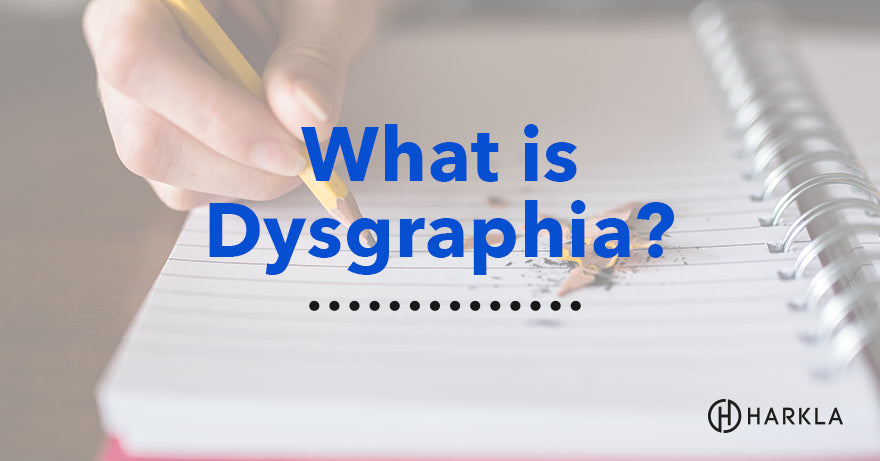Your Cart is Empty

Have you ever heard of dysgraphia? It’s a new word for many people and many people have no idea what it is or what it looks like!
Dysgraphia is a learning disability that affects writing. It typically causes challenges with spelling, overall handwriting, and the ability to put thoughts onto paper - such as for creative writing tasks in school (National Center for Learning Disabilities). These challenges can wreak havoc on a child in the classroom attempting to complete written assignments.
First, let’s talk about what a learning disability is, then we’ll dive into the specific skills required for handwriting, spelling, and creative writing. We’ll also talk about strategies to help if your child struggles with or shows signs of dysgraphia.
What is a learning disability?
According to the Learning Disabilities Association of America, learning disabilities are “a number of disorders which may affect the acquisition, organization, retention, understanding or use of verbal or nonverbal information. These disorders affect learning in individuals who otherwise demonstrate at least average abilities essential for thinking and/or reasoning.”
A learning disability is not something that can be “cured.” Instead, individuals with learning disabilities learn strategies to get through their day successfully. They are typically genetic or neurobiological - meaning they originate in the brain. Anyone can have a learning disability - including individuals with average or above-average intelligence. Therefore, an individual with a learning disability can achieve great achievements in life!
Dysgraphia is a learning disability due to the neurobiological origin - meaning that it originates in the brain and is not typically due to trauma, illness, or any other diagnosis (however, it has been seen in adults as a result of a head injury). Specifically, dysgraphia is a learning disability related to writing.
There are many different skills required for legible handwriting - most of these skills we don’t even think about because, for most of us, it comes naturally through years and years of practice. However, for our children who are struggling with dysgraphia, handwriting is very challenging. Let’s dive into some of the specific skills that are required for handwriting.
Postural control is the ability to maintain an upright posture. This includes standing and maintaining balance while walking, running, or riding a bicycle. It also includes maintaining an upright posture while seated and the ability to “right” yourself when you lose your balance.

Postural control involves four main sensory systems: the visual, vestibular, and proprioceptive systems. The visual system allows us to see and understand our environment, thus allowing us to navigate safely. The vestibular system allows us to maintain our balance while moving through our environment, specifically when we turn our head. And finally, the proprioceptive system allows us to understand where our body is through receptors in our joints and muscles, thus allowing us to move and maintain our posture.
For a child to achieve good handwriting, they must first develop good postural control - they must have the core strength and stability to maintain an upright posture while seated (or standing). If a child struggles with postural control - due to low muscle tone or poor balance - they will most certainly struggle with handwriting.
A child with dysgraphia may or may not have challenges with postural control. Remember, dysgraphia is a learning disability which means it originates in the brain, not necessarily connected to postural control. However, it is still a good idea to take postural control into consideration when addressing handwriting challenges.
Upper body and hand strength is required for legible handwriting - first, there must be good shoulder strength and stability. Then there must be good forearm strength and stability. And finally, the hands and fingers must have good strength and control.
All of this strength is developed throughout infancy and childhood with activities such as tummy time, crawling, climbing, and fine motor tasks such as playing with toys. Self care tasks also help develop the necessary fine motor strength through learning how to manipulate fasteners and other items such as utensils and toothpaste bottles (just to name a few).
A child with dysgraphia may demonstrate fair to good overall strength with gross motor tasks and daily life fine motor tasks, but when it comes to handwriting they may demonstrate some weakness. They may appear to tire easily while writing and they may use an awkward or inefficient grasp on their writing utensil.
Handwriting is a complex task and requires specific visual and motor skills. Visual perception is how our brain interprets what we see and can produce a reaction accordingly. There are several areas of visual perception that affect handwriting.
Visual discrimination is the ability to see similar objects and identify their differences. This is especially important during handwriting in order to discriminate between letters and words.
Visual spatial relations is the ability to understand how objects relate to each other. This is important during handwriting in order to accurately write the letters, space them out, and place them on the given line.
Visual figure ground is the ability to locate an object within a visually busy environment. This is important during handwriting, specifically in order to complete copying tasks, such as copying from the board.
Visual closure is the ability to identify an object without seeing all of it. This is important during handwriting in order to accurately write letters and words. This also affects reading abilities.
Visual form constancy is the ability to identify an object when it is presented differently, like upside down or backwards. This is important to help with visual discrimination skills during handwriting.
Visual memory and visual sequential memory are the abilities to recall items and to recall items in a specific sequence, or order. This is important during handwriting in order to know which letter to write, how to write the letter, and how to spell words.
All of these areas of visual perception will be difficult for a child with dysgraphia. The brain does not interpret the visual information accurately, thus causing difficulty with handwriting tasks.
Additionally, visual motor skills are when we coordinate our vision with a motor action. For handwriting, this is when we coordinate our visual perception with our hand and finger movements to produce writing. A child with dysgraphia may struggle with visual motor integration.
Executive functioning skills include a wide variety of skill sets. The specific executive functioning skills required for handwriting are: organization, planning, sequencing, initiation, memory, impulse control, self-awareness, and flexibility. Because these are all cognitive functions, they can be directly related to dysgraphia.
A child with dysgraphia may struggle with organizing their paper and the letters they write. They may struggle to plan what to write as well as how to sequence those thoughts onto the paper. They may also struggle to initiate a writing task or to remember what they need to write. And they may struggle to identify writing mistakes (also related to their visual perception).
Let’s briefly list out some of the main signs of dysgraphia (National Center for Learning Disabilities).
Additionally, a child with dysgraphia may show signs of poor self-confidence or depression, due to the challenges they face. They often compare their skills to their peers - many children with dysgraphia understand that they are “different” and may feel like they are not “as good” as their peers.
Because dysgraphia is a neurological learning disability, blood tests or scans cannot diagnose it. Instead, an evaluation (or test) can identify the signs and symptoms for a diagnosis. Information is typically gathered from the caregivers and teachers if the child is in school. Then, specific tests are given to the child to identify the challenges.
A licensed psychologist trained in learning disorders can diagnose dysgraphia. This could be your child's school psychologist. The specialist will give your child academic and writing tests that measure their ability to put thoughts into words and their fine motor skills.
Chat with your pediatrician if you suspect that your child is showing signs of dysgraphia.
If you suspect that your child may be showing signs of dysgraphia, or if your child has a diagnosis of dysgraphia, there are some activities that you can complete with them to help! If your child does have a diagnosis of dysgraphia, they will likely have a specific program and interventions.
The activities provided here are not meant to treat, diagnose, or “fix” anyone. They are simply sensory-based activities that target the skills areas related to dysgraphia.

Primitive reflexes have an impact on learning. We are all born with primitive reflexes and these reflexes should naturally integrate as we grow - this means they develop into higher level movement patterns, or “go away.” If a child does not naturally integrate their primitive reflexes (this can happen for a variety of reasons and the reason is oftentimes unknown), challenges in gross motor development, fine motor development, and cognitive development can occur.
You can read more about primitive reflexes here.
When we talk about dysgraphia, there are a couple of primitive reflexes that have been shown to have an impact:
A series of research studies and the outcomes can be found here.
If you’ve never heard of primitive reflexes and their impact on learning, that’s ok! Many people haven’t! But now that you know, let’s talk about what you can do!
First, let’s talk about some of the other signs that these four primitive reflexes may still be present, or retained, along with the signs of dyslexia.
A retained Palmar Grasp Reflex might look like:
A retained TLR might look like:
A retained Spinal Galant might look like:
A retained ATNR might look like:
A retained STNR might look like:
If you suspect that your child might have a retained primitive reflex, the first step is getting an evaluation for occupational therapy or another professional who is trained in primitive reflex integration - physical therapy, cranio-sacral therapy, or chiropractic care are some other options to look into. The goal: to integrate any retained primitive reflexes through a series of specific exercises that create new neural pathways in the brain. Additionally, you can learn more about primitive reflex integration with ourPrimitive Reflex Digital Course.
There are a variety of activities and games that you can play with your child in order to help develop and improve their visual perceptual skills.
There are a variety of activities that you can play with your child to help develop and improve their fine motor skills.
It’s also a great idea to practice handwriting in new and different ways. This can help improve overall handwriting skills, but it can also be fun and motivating!
Some strategies can be utilized to help your child improve their success and self-esteem with school-based writing activities.
This is an excellent review on dysgraphia. I’ve been involved with OTs and other therapists, because of my grandson, as well as being an educator for over 40 years. You did a fine job explaining the basics in a simple language. Thank you.
Comments will be approved before showing up.


Kristi
August 26, 2024
There is no mention in the article of hand/wrist/arm pain as a symptom, and this can be a pretty significant symptom of dysgraphia – as well as one of the symptoms that helps kids get their diagnosis. “Tiring easily” when writing actually usually means that pain develops.
I just wanted to comment the above in case it helps another family, because pain was one of the most significant symptoms of dysgraphia initially for us.